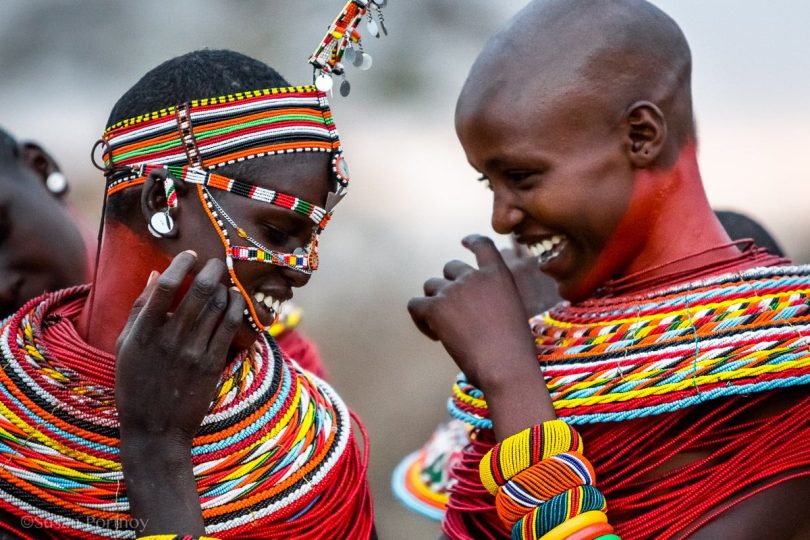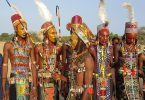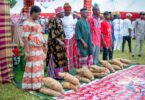There are over 3,000 African tribes, each with its unique dialect and culture. Surprisingly, many African tourists don’t have time to interact with the local people, let alone experience some of their traditions or customs, because they focus most safaris more on wildlife.
Tribal influences are a dominant force in several communities in Africa. They are still a significant force in how people live, talk, and behave, especially in rural areas. With that in mind, below are some of Africa’s most popular tribes.
Table of Contents
Tuareg

African tribes. The Touareg. Photo/Bradshaw Foundation
The Tuareg are the largest Berber ethnic group that live in the Sahara Desert and are among the popular African tribes. They are nomadic pastoralists who migrate in search of food and water. As a result, you can find them in Mediterranean countries like Libya, Niger, and Algeria.
Bedouin
Bedouins are Arabic-speaking nomads who live in North Africa and have spread over Iraq and the Arabian Peninsula. They derived the name from the Arabic word “badawi,” which means “desert dweller.” They raise goats and camels and are predominantly Muslim.
Dogon
The Dogon are a branch of the Niger-Congo dialect. They live in settlements on Mali’s Central Plateau and in Burkina Faso. They are said to have come from the north to escape Islamic revolts.
Their lifestyles revolve around their old religion, however, some are now Muslims and Christians. They are well-known for their art and astrological knowledge. The Dogon thrives on farming and raising livestock.
Yoruba

Yoruba People: African tribes. Photo/The Guardian News Nigeria
The Yoruba, who live nearly entirely in Nigeria’s southwest, are the largest tribe in West Africa. Most of the population in Lagos is Yoruba, and their language still identifies the inhabitants.
Ashanti

African Tribes: Ashanti people. Photo/YouTube
The Ashanti is one of the famous African tribes from Ghana. Their religion is supernatural and spiritual, with ancestors playing a significant role in family life. These characteristics are especially noticeable in rural areas outside of Ghana’s capital, Accra.
Mbenga
The Mbenga, who live in the West Congo Basin, is the most well-known Pygmy Ethnic Group. They speak Bantu and Ubangian. They are hunter-gatherers who rely heavily on the forest for food and barter with their neighbours for other necessities. Although precise figures are difficult to come by, reasonable approximations suggest that the Congo rainforest is home to roughly half a million people.
Hamer

Bull-jumping tradition in Ethiopia. [Photo Culture Trip]
They are easily identifiable by their many multicoloured beads, necklaces, and bracelets adorning their bodies, as well as their peculiar hairstyles, which include curling their hair with a mixture of ochre and butter.
Maasai

Hamer People: African Tribes. Photo/ Garland Magazine
African tribes are not complete without the Maasai people in Kenya and Tanzania along the semi-arid Great Rift Valley. Many of the great East African wildlife parks are within their reach.
The tribe is now semi-nomadic, herding cattle. They believe the sky god Ngai, who lowered them to earth on a leather thong gave the cattle to them. Cattle are cherished and is their source of income and nourishment, with the Maasai diet supplemented by a mixture of cow milk and blood.
Hadzabe

Hadzabe. [Photo: Africa Scavenger]
They use a bow and arrow to hunt while the ladies look for edible berries and fruits. Tourists with an adventurous spirit are welcome to accompany them for a hunt.
The Samburu
The Samburu tribe of north and central Kenya are pastoralists who herd cattle, goats, sheep, and camels.
They have a tight relationship with their southern neighbors, the Maasai, and speak the same Maa language.
San
The San people are one of the world’s oldest tribes and traditional hunter-gatherers. Some live in Botswana, Namibia, Angola, Zambia, Zimbabwe, Lesotho, and South Africa.
The San, also known as the Kalahari Bushmen, have mastered the abilities to hunt and survive in a seemingly barren land. Their tracking abilities are legendary, as is their success with poisoned arrows and bows. They collect whatever fruit and berries are in season and locate water in underground tubers.
Zulu
Zulu is the largest ethnic group in South Africa with a population of roughly 11 million people. The Zulu are a warrior tribe said to have descended from East Africa, and migrated to the south centuries ago to find a home in KwaZulu-Natal on South Africa’s Indian Ocean Coast.
The Zulu maintain close ties to their history and culture by offering sacrifices to ancestral spirits who impact their daily life.
Southern Ndebele
The Southern Ndebele tribe lives in Gauteng, Limpopo, and Mpumalanga, and they speak a language similar to the Zulu. They do, however, have a special culture and beliefs that separate them from other African tribes.
The Ndebele believe that spells or curses are external powers inflicted on a person to create illness. A sangoma (a type of traditional healer) must fight these forces with traditional herbal medicines and bone throwing to treat disease. While these shamanistic traditions are intriguing, Southern Ndebele’s artistic style is genuinely unique.
Xhosa, South Africa

African Tribes Xhosa. The New York Times
The Xhosa ethnic group lives in the forested Eastern Cape Province in the country’s southeast. After Zulu, Xhosa is South Africa’s second most spoken language. This language is used to preserve their strong oral tradition, which includes stories of ancestral heroes and elders’ lessons passed down through the generations solely by speech.
Karo
The small Karo or Kara tribe lives on the banks of the Omo River in Southern Ethiopia, seemingly undisturbed by the outside world. They survive by cultivating flood-relief crops, farming beans, and maize, rearing cattle and goats, and fishing.








